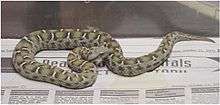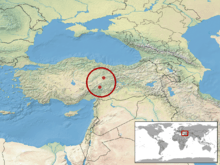Montivipera albizona
Montivipera albizona, the central Turkish mountain viper,[2] is a venomous viper species endemic to the mountainous regions of central Turkey.[2] No subspecies are currently recognized.[3]
| Montivipera albizona | |
|---|---|
 | |
| Scientific classification | |
| Kingdom: | Animalia |
| Phylum: | Chordata |
| Class: | Reptilia |
| Order: | Squamata |
| Suborder: | Serpentes |
| Family: | Viperidae |
| Genus: | Montivipera |
| Species: | M. albizona |
| Binomial name | |
| Montivipera albizona | |
 | |
Description
The maximum total length is a little less than 78 cm (31 in) (for a male), although most specimens are smaller.[2]
The head is relatively large and distinct from the neck. The snout is rounded and covered with small, keeled scales. The nostril is located within a single nasal scale. There are 2-3 apical scales in contact with the rostral. There is normally 1 canthal scale on either side of the head. The large supraoculars are in broad contact with the eye. There are 9-13 circumorbitals. Two scale rows separate the eye from the supralabials, of which there are 7-10. There are usually 10-13 sublabials. The temporal scales are keeled.[2]
Midbody there are 23 rows of keeled dorsal scales. There are 2-3 preventral scales, followed by 149-155 ventrals. The anal scale is single and followed by 23-30 paired subcaudals.[2]
The color pattern consists of a grayish ground color. Running along the midline from the back of the head to the tail is a series of about 30 transversed and pronounced white- and black-edged narrow bands separated by a brick-red brown zone 3-4 scales long and 9-12 scales wide. Lateral spots may be small and in a double series. There are usually two large black, oblique spots on top of the head, as well as a dark stripe running from the corner of the eye back to the angle of the mouth or beyond. The belly is grayish and finely speckled with darker spots.[2]
Geographic range
Central Turkey. The type locality given is "from the regions of the Kulmac Daglari mountain range, central Turkey, close to the Anatolian diagonal".[1]
Conservation status
This species is classified as Endangered (EN) according to the IUCN Red List of Threatened Species with the following criteria: B1+2e, C2a (v2.3, 1994).[4] This indicates that the extent of its occurrence is estimated to be less than 5,000 km2 (2,000 sq mi) or the area of its occupancy is estimated to be less than 500 km2 (200 sq mi). Estimates also indicate that the populations are severely fragmented or known to exist at no more than five locations, and that a continuing decline is inferred, observed or projected, in the number of mature individuals. In addition, the total population is estimated to number less than 2,500 mature individuals with no subpopulation containing more than 250 such specimens. Year assessed: 1996.[5]
It is also listed as a strictly protected species (Appendix II) under the Berne Convention.[6]
Habitat
Very rocky and dry mountain slopes and fields.[2]
Taxonomy
After Nilson et al. (1990) first described M. albizona as a separate species that is parapatric with M. xanthina,[2] a group of opponents led by Schätti soon argued that V. albizona, M. wagneri and M. bulgardaghica were more likely conspecific, belonging to the polymorphic species, M. xanthina. According to Bettex (1993), it was also difficult to tell M. albizona from M. wagneri based on color pattern alone. However, a study published by Mulder (1994) came out in support of Nilson et al. (1990) and asserted that the color pattern of M. albizona is actually quite distinct from that of M. wagneri.[7]
References
- McDiarmid RW, Campbell JA, Touré T. 1999. Snake Species of the World: A Taxonomic and Geographic Reference, Volume 1. Herpetologists' League. 511 pp. ISBN 1-893777-00-6 (series). ISBN 1-893777-01-4 (volume).
- Mallow D, Ludwig D, Nilson G. 2003. True Vipers: Natural History and Toxinology of Old World Vipers. Krieger Publishing Company, Malabar, Florida. 359 pp. ISBN 0-89464-877-2.
- "Vipera albizona". Integrated Taxonomic Information System. Retrieved 13 August 2006.
- Vipera albizona at the IUCN Red List. Accessed 2 September 2007.
- 1994 Categories & Criteria (version 2.3) at the IUCN Red List. Accessed 2 September 2007.
- Convention on the Conservation of European Wildlife and Natural Habitats, Appendix II at Council of Europe. Accessed 9 October 2006.
- Mulder J. 1994. Additional information on Vipera albizona. Deinsea 1: 77-83. ISSN 0923-9308. PDF Archived 2006-10-03 at the Wayback Machine at Natuurhistorisch Museum Rotterdam. Accessed 2 October 2006.
Further reading
- Bettex F. 1993. Beobachtungen an Vipera bulgardaghica, Vipera albizona und Vipera xanthina im Freiland und im Terrarium. Herptofauna 15 (86): 21-26.
- Nilson B, Andrén C, Flärdh B. 1990. Vipera albizona, a new mountain viper from central Turkey, with comments on isolating effects of the Anatolian 'Diagonal'. Amphibia-Reptilia 11 (3): 285-294.
- Schätti B, Baran I, Sigg H. 1992. The Vipera xanthina complex - a reply to Nilson and Andrén. Amphibia-Reptilia 13: 425.
External links
| Wikimedia Commons has media related to Montivipera albizona. |
- Montivipera albizona at the Reptarium.cz Reptile Database. Accessed 2 September 2007.
